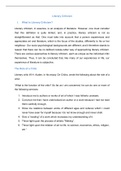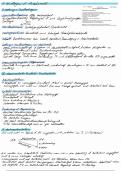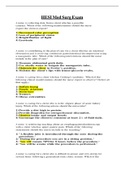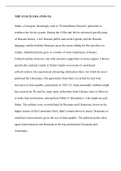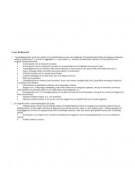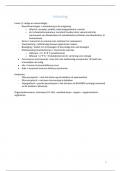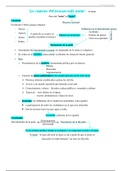Literary Criticism
I. What Is Literary Criticism?
Literary criticism, in essence, is an analysis of literature. However, one must consider
that this definition is quite limited, and, in practice, literary criticism is not as
straightforward as that. One must take into account that a person experiences and
appreciates art and literature, which is the focus of the studies, differently to his or her
neighbour. Our socio-psychological backgrounds are different, and it therefore stands to
reason that there can be no defined cookie-cutter way of approaching literary criticism.
There are various approaches to literary criticism- each as unique as the individual critic
themselves. Thus, it can be concluded that, like many of our experiences in life, our
experience of literature is subjective.
The Role of a Critic
Literary critic W.H. Auden, in his essay On Critics, wrote the following about the role of a
critic:
“What is the function of the critic? So far as I am concerned, he can do one or more of
the following services:
1. Introduce me to authors or works of art of which I was hitherto unaware.
2. Convince me that I have undervalued an author or a work because I had not read
them carefully enough.
3. Show me relations between works of different ages and cultures which I could
never have seen for myself because I do not know enough and never shall.
4. Give a “reading” of a work which increases my understanding of it.
5. Throw light upon the process of artistic “Making”.
6. Throw light upon the relation of art to life, to science, economics, ethics, religion,
etc.”
, II. Anglo-American New Criticism (New Criticism)
New criticism provided a direct response to traditional critical practices- which focused
on how a text is shaped by external influences, whether historical, social, or cultural.
Originating in the late 1920s and early 1930s, new criticism concerned itself with the
idea of ‘art for art’s sake’. New critics believed that a text should be regarded as
autonomous, and should therefore be judged on its own merit, as belonging to an
established Western tradition of art, rather than how it provides commentary about ‘real’
world. The complexity of form, technique, and organisation were, thus, carefully
scrutinised by the critic through a close reading of the text— “ a close and detailed
analysis of the text itself to arrive at an interpretation without referring to historical,
authorial, or cultural concerns” (Bressler, 2003:263)
In order to preserve the artistic integrity and unity of the text, the new critic needed to be
aware of investing value in the consideration of the author’s intentions (intentional
fallacy) and the emotional response of the reader (affective fallacy). According to New
Critical methods, the critic should also avoid summarising or paraphrasing when
interpreting the text as this will result in a heresy of paraphrase.
Major figures in the New Critical Movement include T.S. Eliot, Cleanth Brook, Allen
Tate, F.R. Leavis, Robert Penn Warren, William Empson, and John Crowe Ransom.
III. Marxist Literary Criticism
Where the new critics regarded the text as autonomous, the Marxist critics’ approach to
literature was on the basis on sociological influence— that texts are products of the
historical, economic, and cultural circumstances in which they were created. Texts from
whichever historical period are regarded as subjective in that they only reflect the
dominant class’s ideology. As such, Marxist critics believe that literary works from a
particular period should be viewed simultaneously as reflecting historical context as well
as being autonomous in that they are subjective and, in their subjectivity, cannot be
measured as indicative of an objective reality.
I. What Is Literary Criticism?
Literary criticism, in essence, is an analysis of literature. However, one must consider
that this definition is quite limited, and, in practice, literary criticism is not as
straightforward as that. One must take into account that a person experiences and
appreciates art and literature, which is the focus of the studies, differently to his or her
neighbour. Our socio-psychological backgrounds are different, and it therefore stands to
reason that there can be no defined cookie-cutter way of approaching literary criticism.
There are various approaches to literary criticism- each as unique as the individual critic
themselves. Thus, it can be concluded that, like many of our experiences in life, our
experience of literature is subjective.
The Role of a Critic
Literary critic W.H. Auden, in his essay On Critics, wrote the following about the role of a
critic:
“What is the function of the critic? So far as I am concerned, he can do one or more of
the following services:
1. Introduce me to authors or works of art of which I was hitherto unaware.
2. Convince me that I have undervalued an author or a work because I had not read
them carefully enough.
3. Show me relations between works of different ages and cultures which I could
never have seen for myself because I do not know enough and never shall.
4. Give a “reading” of a work which increases my understanding of it.
5. Throw light upon the process of artistic “Making”.
6. Throw light upon the relation of art to life, to science, economics, ethics, religion,
etc.”
, II. Anglo-American New Criticism (New Criticism)
New criticism provided a direct response to traditional critical practices- which focused
on how a text is shaped by external influences, whether historical, social, or cultural.
Originating in the late 1920s and early 1930s, new criticism concerned itself with the
idea of ‘art for art’s sake’. New critics believed that a text should be regarded as
autonomous, and should therefore be judged on its own merit, as belonging to an
established Western tradition of art, rather than how it provides commentary about ‘real’
world. The complexity of form, technique, and organisation were, thus, carefully
scrutinised by the critic through a close reading of the text— “ a close and detailed
analysis of the text itself to arrive at an interpretation without referring to historical,
authorial, or cultural concerns” (Bressler, 2003:263)
In order to preserve the artistic integrity and unity of the text, the new critic needed to be
aware of investing value in the consideration of the author’s intentions (intentional
fallacy) and the emotional response of the reader (affective fallacy). According to New
Critical methods, the critic should also avoid summarising or paraphrasing when
interpreting the text as this will result in a heresy of paraphrase.
Major figures in the New Critical Movement include T.S. Eliot, Cleanth Brook, Allen
Tate, F.R. Leavis, Robert Penn Warren, William Empson, and John Crowe Ransom.
III. Marxist Literary Criticism
Where the new critics regarded the text as autonomous, the Marxist critics’ approach to
literature was on the basis on sociological influence— that texts are products of the
historical, economic, and cultural circumstances in which they were created. Texts from
whichever historical period are regarded as subjective in that they only reflect the
dominant class’s ideology. As such, Marxist critics believe that literary works from a
particular period should be viewed simultaneously as reflecting historical context as well
as being autonomous in that they are subjective and, in their subjectivity, cannot be
measured as indicative of an objective reality.

